A homegrown harvest of sweet summertime strawberries, warmed by the sun, is one of life’s great pleasures.
And there is a huge variety of cultivars out there – over 200 currently – for your fresh eating, jam-making, and pie-filling pleasure.
We’ve put together a thorough roundup of 35 of what we believe to be the best types, with information on growing zones, growth habits, berry quality, disease resistance, and more.
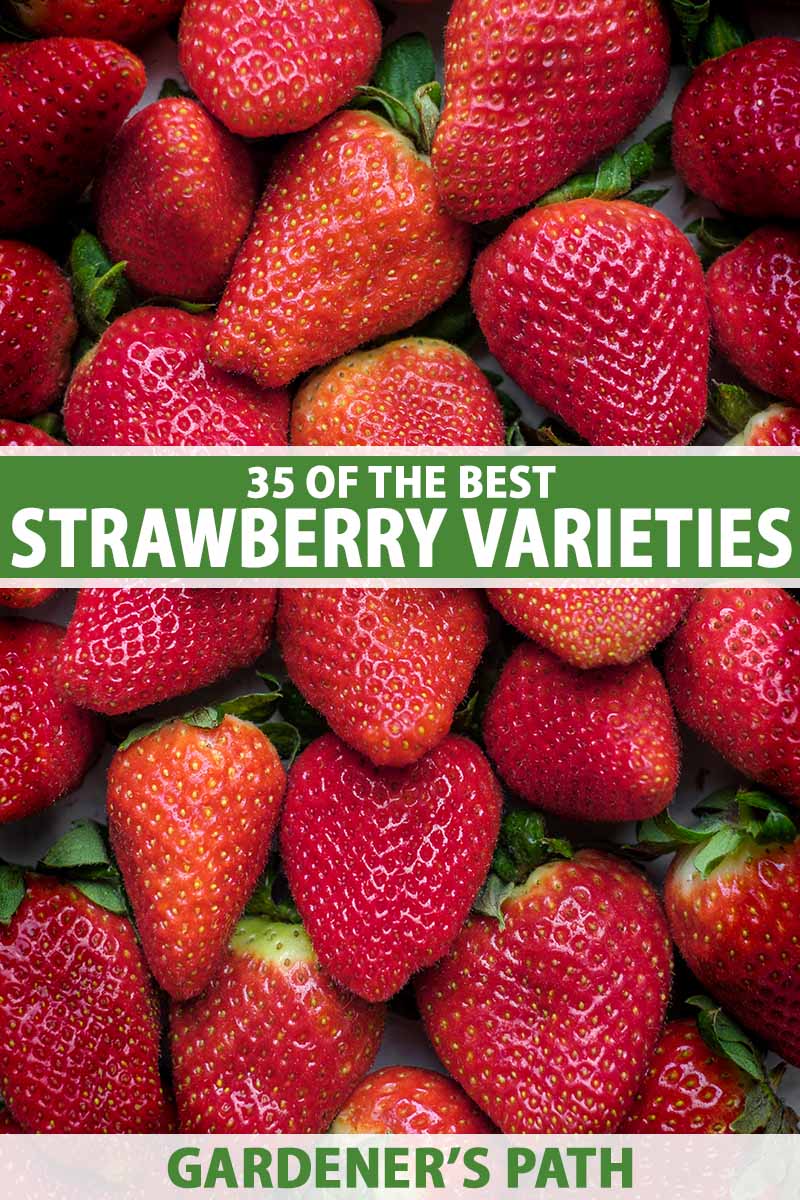
We link to vendors to help you find relevant products. If you buy from one of our links, we may earn a commission.
This will make it easier for you to pick the best strawberry cultivars for your location and gardening style.
While some are tried-and-true favorites, others are newly popular. Whether you’re looking for that classic strawberry flavor or something a little different, we’re confident that our list will not disappoint.
Let’s get growing!
Strawberry Varieties for Your Garden
First up, if you need a more thorough refresher on what these plants are all about and how to care for them, take a look at our guide to growing strawberries at home.
Here, I’ll provide a quick recap that will help you to understand the terminology used in the descriptions below.
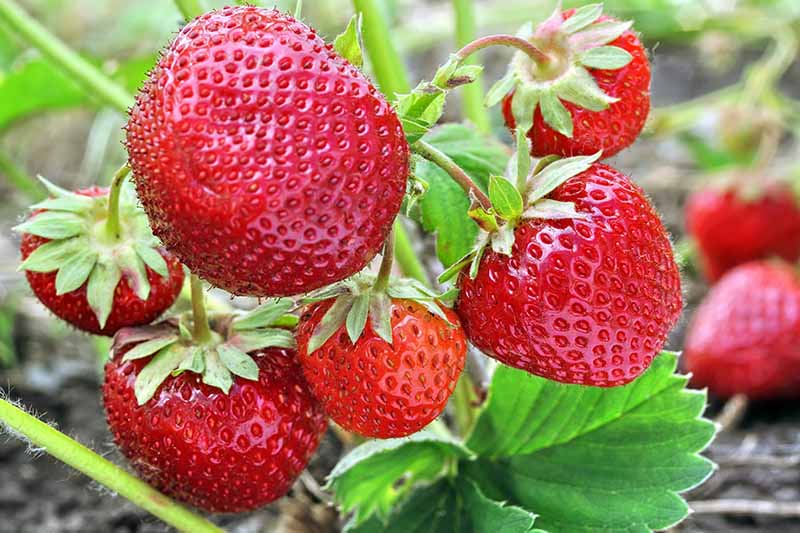
While most varieties of cultivated strawberries that you’ll come across are members of the Fragaria x ananassa species, some are alpine or wild cultivars of F. vesca.
We’ll point these out for you, as well as any others belonging to a species other than the typical F. x ananassa.
Strawberries with a mounding habit produce growth both vertically and horizontally, giving the plants a rounded appearance.
Those with a prostrate habit, also referred to as spreading or creeping, tend to produce growth more horizontally, spreading across the ground.

Prostrate varieties are great for raised beds and larger planting spaces, whereas mounding varieties are well-suited to containers and hanging planters.
You’ve probably heard about chill hours in tree fruits before, and these apply to strawberries as well.
Most types have a certain number of required chill hours, while a few do not. What this means is if they don’t receive the required number of hours between 45 and 32°F, blossoms may not develop fully or open, resulting in lower yields.
This tally includes hours before and after harvest, when plants are dormant. Most strawberry plants require 200 to 300 chill hours for the best fruit production.
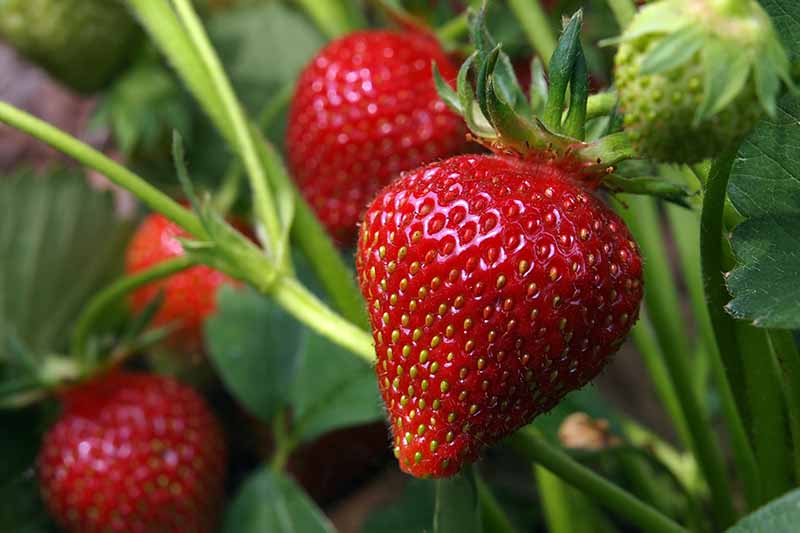
How is this relevant to home growers?
The main factor here is that if you live in a location that doesn’t experience cold wintertime weather, certain cultivars will not produce fruit, or yields will be small.
Most types tend to be more productive after their first year of growth, and growers remove blossoms during the first year.
Though it’s tempting to get that first harvest going (I know!) removing the first-year blooms (or at least the first batch of these – more on that later) helps the plants to put their energy into healthy root and runner development.
Strong, healthy plants that don’t have to put huge amounts of energy into flower and fruit production in the first year produce better fruit in the following season.
Strawberries are perennial plants, and most remain productive with good yields for three to four years.
Many growers propagate plants from runners while others start new plants every couple of seasons. Propagating at home is not permitted for some patented varieties.
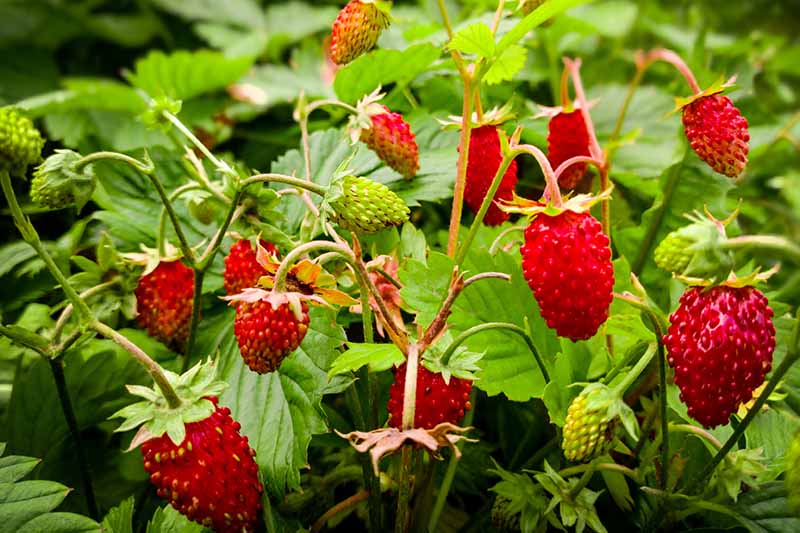
Though some strawberry plants are monoecious, meaning they have both male and female parts on each blossom, self-pollination is sometimes not enough to achieve high yields.
Strawberries are typically self-fertile, with varying levels of success depending on the cultivar and growing conditions, and they are pollinated by wind and insects as well.
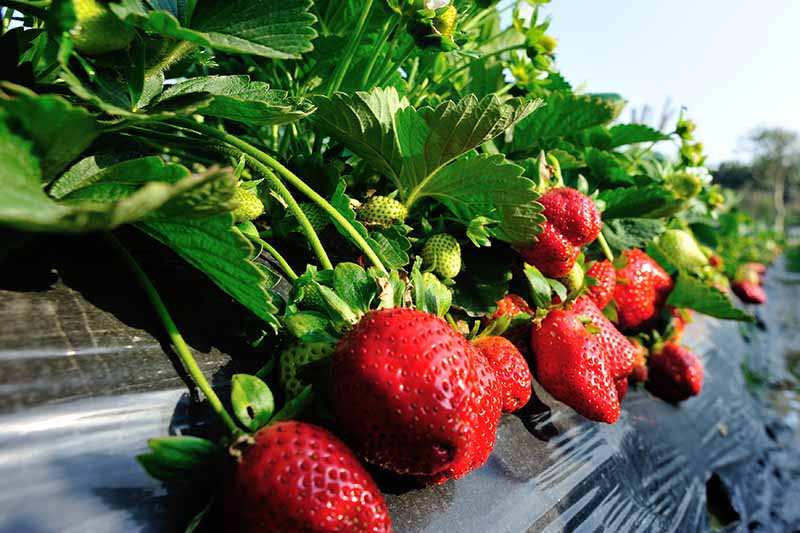
You’ll also be faced with another choice in terms of harvest, with three options to choose from:
Everbearing varieties produce three crops, during spring, summer, and fall. During the heat of the summer, most of these tend to produce less fruit than they do during the other two harvest periods. And they generally produce fewer runners than other types as well.
Many growers will remove blossoms from their first-year everbearing plants until around June 1st, and then allow later blossoms to develop into fruit for two harvests in the first year.
June-bearing types produce one large crop over the course of about a month during the spring, and these may be further broken down into early, mid-season, and late varieties. This relates to bloom time, and the production of fruit to follow.
Remove all of the flowers from June-bearing strawberry cultivars during the first year of growth, so they can devote their energy to developing strong roots and runners.
Finally, day-neutral cultivars are kind of like indeterminate tomatoes. Flower and fruit production are ongoing through the growing season, as long as temperatures don’t dip below 35°F, or soar above 85°F in the case of a summertime heatwave.
Like everbearing types, these produce few runners, and flowers should be removed from first-year plants until the beginning of June. After that, you can allow your baby plants to develop fruit through the summer and into the fall.
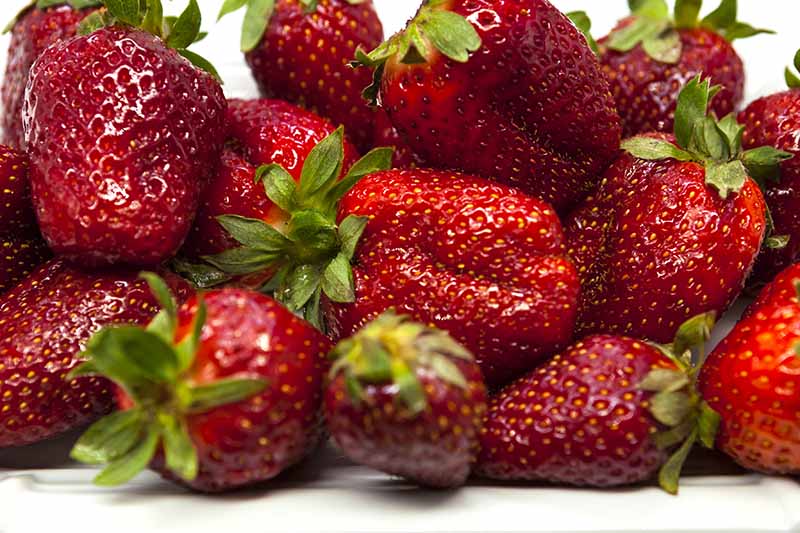
What does this mean for planning and planting?
Well, it all depends on where you live.
In cold USDA Hardiness Zones 6 and lower, strawberries should be planted in the spring. This gives them enough time to become established before the cold winter weather sets in.
Growers in warm Zones 7 and up typically plant around Labor Day for harvests beginning the following spring.
In addition to our descriptions of the best cultivars and what they have to offer, we’ve included a selection of strawberry seeds, bare roots, and live plants that are available from our trusted affiliates.
It’s time to pick your favorites and start planning the berry patch of your dreams!
1. AC Wendy
A vigorous early-season ‘Evangeline’ cross developed at the Kentville research station in Nova Scotia, ‘AC Wendy’ is known for its runner production and high fruit yields.
This variety isn’t picky – it does well in full sun and can be planted in both light and heavy soils.
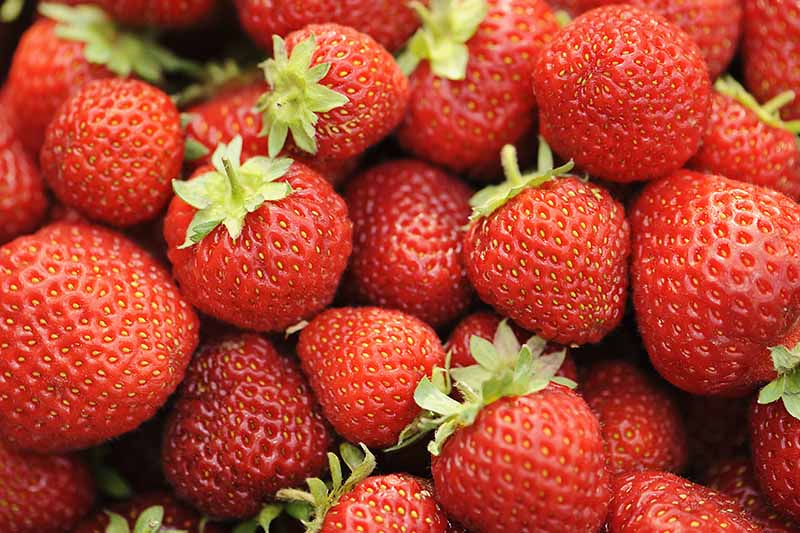
Conical to wedge-shaped large fruits ripen early on this cold-tolerant June-bearing variety, which thrives in Zones 4 to 8.
The berries have a firm texture and are known for holding up well to freezer storage after harvest.
But since they produce their white flowers early, this also means there’s a potential for frost damage. Be sure to protect your crops in the case of a late freeze.
Vigorous growers with a prostrate habit, a mature height of 12 inches, and a spread of 24 to 36 inches, these plants are moderately resistant to powdery mildew and red stele fungal disease. But they are susceptible to verticillium wilt and angular leaf spot.
Packages of 25 bare root plants are available from Burpee.
2. Albion
These day-neutral sweeties have a high sugar content and they’re sure to please in terms of flavor.
A cross of ‘Diamante’ and ‘Cal 94.16-1’ developed at the University of California and released in 2006, ‘Albion’ produces long, conical fruit with a firm texture.
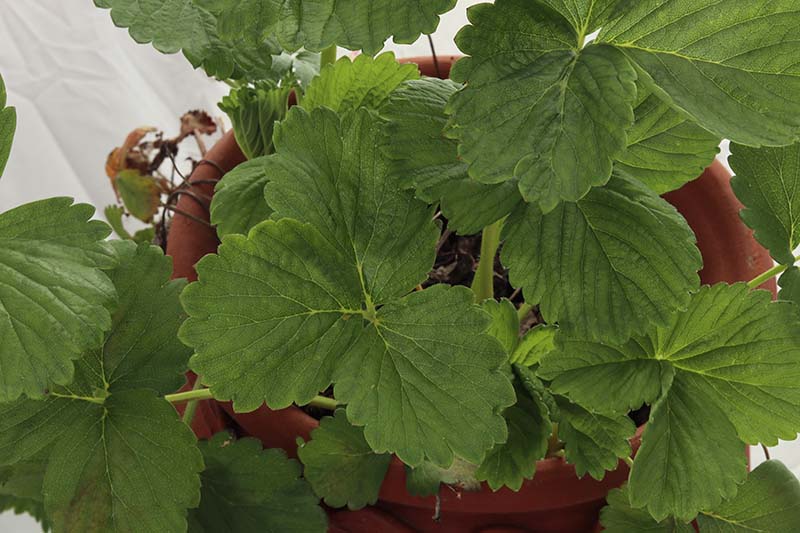
Resistant to verticillium wilt, Phytophthora crown rot, and anthracnose crown rot, this type is known for producing high yields of one to three pints of fruit per plant.
‘Albion’ does best if grown in full sun in Zones 4 to 8 (though some claim there’s some wiggle room here, expanding that range to Zones 3 to 9). Fragrant white flowers are attractive to pollinators.
With a mounded growth habit, height of 12 inches, and spread of 24 to 36 inches at maturity, 500 chill hours are required for good yields. With a moderate to fast growth rate, expect 90 days to harvest.
Packages of 25 bare root plants are available from Burpee.
3. All Star
A reliable cultivar developed by the USDA and plant breeders at the University of Maryland, this cross of ‘US 4419’ and ‘MDVS 3184’ was first released in 1981.
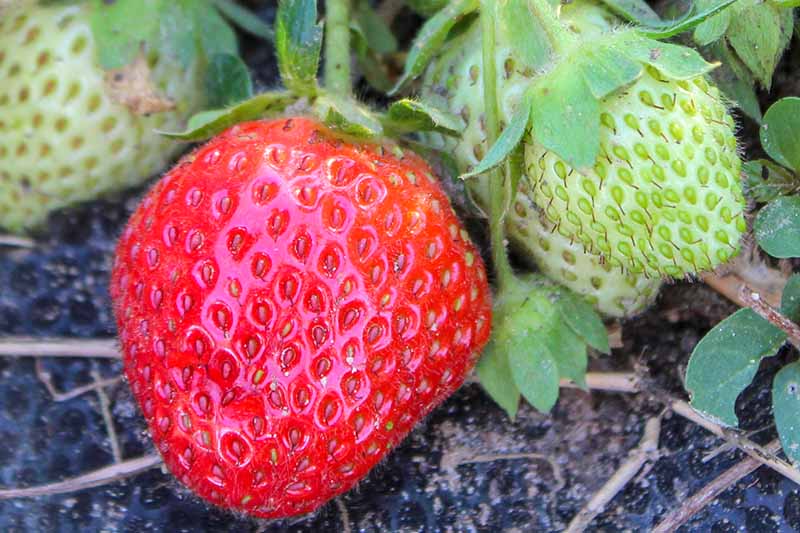
‘All Star’ (or ‘Allstar’) has white flowers, and large fruit with a sweet and mild flavor. A firm texture means your harvest will hold up well to freezer storage.
This midseason June-bearing variety is highly resistant to red stele, and moderately resistant to verticillium wilt. It can even be planted in clay or sandy soils.
Plants are suited to Zones 6 to 8, where they will grow to a height of about 10 inches with a spread of 18 inches.
Bare root plants in packages of 25 are available from Nature Hills Nursery.
4. Alpine Alexandria
An heirloom alpine type, ‘Alexandria’ is a cultivar of F. vesca. It produces white flowers and teeny-tiny berries known for their delicious and distinct flavor and texture.
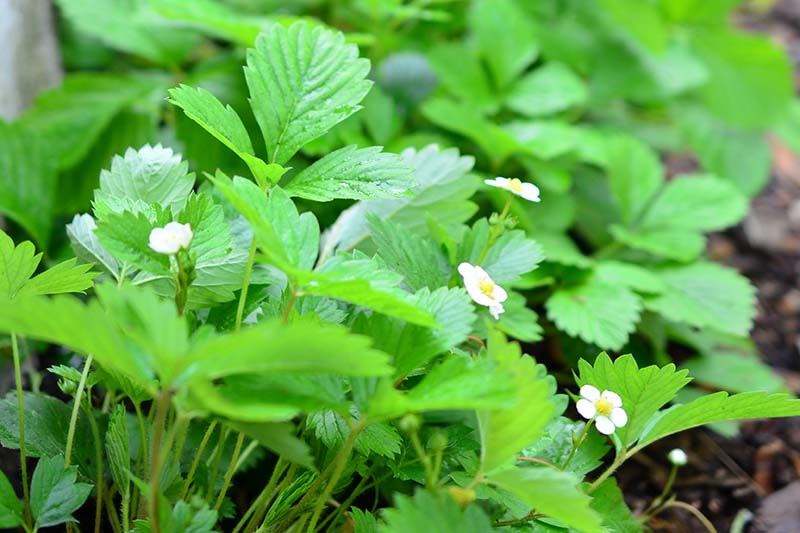
High yielding, runnerless, everbearing plants are happiest with some room to spread out, at least 18 inches between plants, and this type is also suited to growing as a ground cover.
Grow it in containers if you don’t want it to spread.
Planted in full sun to partial shade in Zones 6 to 8, you can expect this type to reach a height of eight to 10 inches.
Plants are available from Burpee.
5. Alpine Yellow Wonder
Looking for something a little different? How about strawberries that ripen to a pale yellow color?
Known for their gourmet flavor and an aroma reminiscent of pineapple, these tiny treats are less attractive to birds than their red counterparts, so there’s sure to be plenty of fruit left on the plant for you when harvest time rolls around.
This everbearing F. vesca cultivar produces white flowers, and is known for its high yields of small berries that are easy to pick from their stems.
‘Yellow Wonder’ does best in full sun in Zones 6 to 8. It has a prostrate growth habit, height of eight to 10 inches at maturity, and a spread of 14 to 18 inches.
Plants are available from Burpee.
6. Alpine White Soul
Not only does this F. vesca cultivar boast a ghostly white color when ripe, it has an unusual flavor as well. Some say these taste like tropical fruit, others note hints of grape or rose.
If you’ve tried them before, please let us know in the comments what you think they taste like!
You won’t need to worry about protecting your crops with netting since birds won’t typically go after the colorless fruits, but you may want to lay out some shade covers to prevent sunburn.
These vigorous everbearing plants produce white flowers, and they do best in full sun in Zones 6 to 8. They have a prostrate growth habit, with a height of eight to 10 inches at maturity and a spread of 14 to 18 inches.
Plants are available from Burpee.
All three types of alpine strawberries described above are also available as live plants in a convenient three-pack. You can find Burpee’s Alpine Collection here.
7. Berries Galore Pink Hybrid
Mature in 75 days, this hybrid everbearing variety produces sweet, medium-sized, pinkish-red fruit that can typically be harvested every three days or so throughout the season.
This type is hardy in Zones 5 to 9 with large, early, pink flowers. It has a height of six to 12 inches at maturity and a spread of 18 inches.
Packages of 100 seeds are available from True Leaf Market.
8. Camarosa
An early midseason June-bearing cultivar, ‘Camarosa’ does well in warmer climates. In fact, this type is well-adapted to southern California in particular, and other hot areas at low latitudes.
Large and flat wedge-shaped fruits, similar to those you will often see at the grocery store, have a firm texture and good flavor.
A cross of ‘Douglas’ and ‘Cal 85.281-605’ bred at the University of California and released in 1992, it’s a relatively heat-tolerant variety, but best grown in Zones 5 to 8.
‘Camarosa’ produces white flowers and loves full sun. Mature plants reach a height of 10 to 12 inches with a spread of eight to 12 inches and a prostrate growth habit.
Plants are available from Burpee.
9. Chandler
A midseason June-bearing cultivar, ‘Chandler’ produces firm, large, flavorful berries with that classic conical shape that you know and love.
Best suited to full sun conditions in Zones 5 to 8, this cultivar has a prostrate growth habit with a mature height of six to eight inches and a spread of 12 to 18 inches.
Bred at the University of California and released in 1983, this is a cross between ‘Douglas’ and ‘Cal 72.361-105.’
‘Chandler’ produces good yields in southern states, and it is adaptable to eastern regions of the US as well.
It has white flowers, and it’s also worth noting that this cultivar is susceptible to anthracnose disease.
Plants are available from Burpee. You can also find 10 bare roots available from Walmart.
10. Charlotte
You’ll appreciate multiple harvests of sweet berries from June through first frost in the fall with this everbearing variety, even during the heat of the summer. And pollinators love the magenta-pink flowers.
This cultivar has good cold tolerance, and is tolerant of mites and powdery mildew as well.
A French cross between ‘Mara des Bois’ and ‘Cal 19,’ ‘Charlotte’ is a vigorous grower that does best in full sun in Zones 3 to 8.
It reaches a mature height of eight to 10 inches with a spread of eight to 12 inches. Five hundred chill hours are required for good yields, and you can expect 75 days to harvest.
You can find packages of 10 plants available from Home Depot.
11. Delizz
Noteworthy as the first strawberry to be chosen as an All-America Selections Winner back in 2016, this type is great for growing in containers.
Very sweet, medium-sized conical berries grow on strong stems – so they won’t fall off before they’re ripe.
This everbearing hybrid produces white flowers. Best suited to full sun locations in Zones 3 to 8, this cultivar has a mounding habit, with a height and spread of 10 to 24 inches.
Plants are available from Burpee.
12. Delizzimo
If you’re looking for fruit that’s ready for harvest early in the season right through to early fall, ‘Delizzimo’ does not disappoint.
With small, white flowers, this compact everbearing variety has a mounding habit, and it’s known for high yields of fruit with a sweet flavor.
Grow it in full sun in Zones 3 to 8. Plants have a height and spread of 10 to 24 inches at maturity.
Plants are available from Burpee.
13. Earliglow
Possibly the earliest cultivar to produce a harvest during the growing season, ‘Earliglow’ is an early-season June-bearing variety.
It produces high yields of sweet, medium-sized, cone-shaped berries with a firm texture, so they’ll hold up to processing and freezing.
With a height of 12 inches and a spread of 24 to 36 inches at maturity, and a prostrate growth habit, this cultivar grows best in full sun in Zones 4 to 8.
With excellent resistance to red stele, and moderate resistance to root rot and verticillium wilt, this type is regarded as a good option for beginners.
Fragrant white flowers are attractive to pollinators, and it has a mounded habit.
For the best harvest, 500 chill hours are required. Berry size tends to decrease as the season progresses.
Plants and bare roots ready for planting are available from Burpee. Bare root plants in packages of 25 are also available from Gurney’s via Home Depot.
14. Elan
A late season everbearing variety that produces yields from July to October, shiny biconical berries are known for being easy to pick – the calyx breaks easily when fruits are ripe.
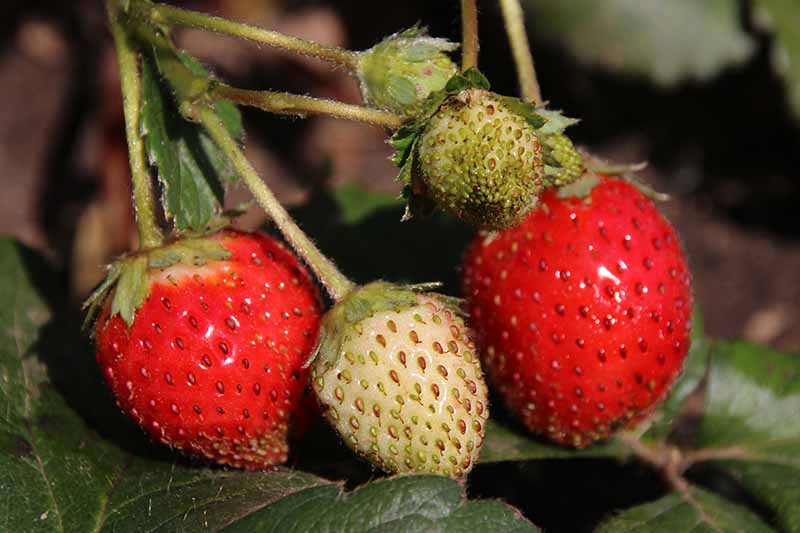
Another F1 hybrid, ‘Elan’ grows true to seed and has white flowers.
Grow these vigorous plants in full sun in Zones 5 to 8. You can expect a height of eight to 10 inches and spread of 14 to 18 inches at maturity, with a prostrate growth habit.
Plants are available from Burpee.
15. Eversweet
With cone-shaped berries that are particularly flavorful, this cultivar is known for being exceptionally heat tolerant.
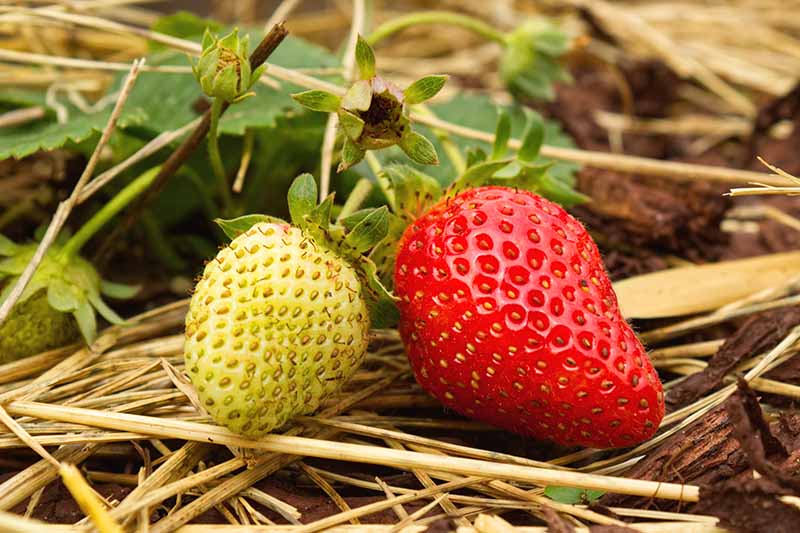
In fact, it was bred specifically for growing in the southeastern US.
Expect the best yields in full sun locations in Zones 5 to 8. It does well in containers and small spaces, and is even known for producing quality fruit in its first year.
This everbearing variety has white flowers, and plants reach a height of 12 to 16 inches with an equal spread at maturity.
Deer and disease resistant, it has no chill hour requirements and a prostrate growth habit. Expect 90 days to harvest.
Bare root plants in packages of 25 are available from Burpee.
16. Evie-2
If you just can’t get enough strawberries throughout the growing season, you can expect three crops of flavorful fruit in the spring, summer, and fall with this day-neutral cultivar.
Developed by Edward Vinson Ltd. in the UK and released in 2006, this cross of ‘Everglade’ and ‘J92D12’ is best grown in full sun in Zones 4 to 8.
‘Evie-2’ is less sensitive to warm summer temperatures than other day-neutral varieties that may produce a smaller summertime harvest, with a prostrate growth habit.
In fact, it’s known for producing one of the highest yields of all the day-neutral cultivars.
This type produces white flowers. Expect a mature height of 12 to 15 inches and a spread of 12 to 24 inches.
Packages of 25 bare root plants are available from Burpee.
17. Flavorfest
A mid-season June-bearing variety developed by the USDA’s Agriculture Research Service in Beltsville, Maryland and released in 2012, this one’s big on flavor with high yields of large, plump berries.
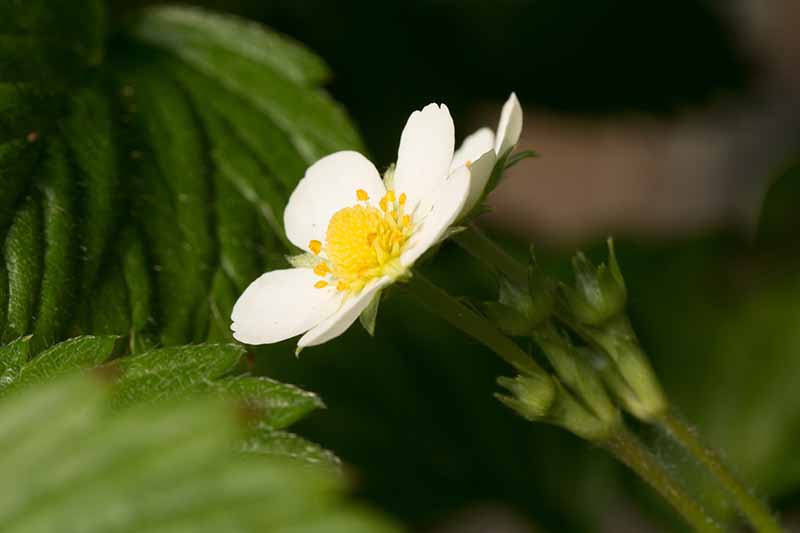
Vigorous plants with white flowers are known for responding well to propagation, and they’re resistant to red stele and resistant or tolerant of most stem and leaf diseases known to plague strawberries. ‘Flavorfest’ is not susceptible to anthracnose crown and fruit rot.
Grown in full sun in containers or beds, ‘Flavorfest’ has a prostrate growth habit, with a height and spread of 12 to 16 inches at maturity.
It’s best suited to the Mid-Atlantic and northeastern regions of the US in Zones 4 to 7.
For the best yields, 600 chill hours are required, with only 30 days to harvest.
Plants and bare roots ready for planting are available from Burpee.
18. Galletta
A super hardy and vigorous cultivar that’s particularly disease resistant, this option is excellent for organic gardeners.
You won’t have to worry about black root rot, black vine weevils, or red stele with ‘Galletta.’ And it can be grown in heavy soil as well.
An ‘Earliglow’ and ‘NCH 87-22’ cross developed by Jim Ballington at North Carolina State University and released in 2010, this is an early-season June-bearing cultivar with white flowers and large, firm, aromatic berries.
Best in Zones 4 to 7 in full sun, particularly in the Piedmont and Mountain regions of North Carolina, you can expect a height and spread of 12 to 16 inches at maturity and a prostrate growth habit.
Bare root plants are available from Burpee.
19. Grande Berried Treasure Red
With stunning rose-colored semi-double flowers, trailing runners, and medium-sized red berries, this is an excellent option for containers.
Grow it in full sun in Zones 4 to 9.
You can expect a height of 12 to 16 inches and spread of 18 to 24 inches at maturity.
This type has a mounded habit, no chill hour requirements, and you can expect about 28 days to harvest.
Live plants are available in four-packs from Proven Winners via Home Depot.
20. Honeoye
This cultivar was developed at Cornell University by plant breeders at the New York State Agricultural Experiment Station (NYSAES) and released in 1979.
A cross of ‘Vibrant’ and ‘Holiday,’ it was a top seller for decades, and remains popular among growers today.
Early midseason June-bearing plants produce white flowers and very high yields of medium-sized, bright red berries.
These are known for their relatively firm texture and for holding their color in processing, so they’re great for home canning.
Grow ‘Honeoye’ in full sun in Zones 3 to 9. This type is relatively adaptable, but it does best when planted in loamy, light soil and makes a lovely addition to raised beds.
You can expect a maximum height of eight to 10 inches with a spread of 12 inches.
Unfortunately, this cultivar does not exhibit any particular types of soil disease resistance, and it is susceptible to black root rot.
Bare root plants in packages of 25 are available from Gurney’s via The Home Depot and Nature Hills Nursery.
21. Jewel
Producing large, juicy, wedge-shaped berries with a solid red hue inside and out, ‘Jewel’ berries are known for freezing well, and harvested fruit resists rotting in storage.
This late midseason June-bearing variety has fruit that’s easy to pick, with a low-growing prostrate habit, a max height of 12 inches, and a spread of 24 to 36 inches.
Developed at Cornell/NYSAES and released in 1985, ‘Jewel’ is a cross of ‘Senga Sengana’ and ‘NYE58’ with ‘Holiday.’
Best grown in full sun in Zones 4 to 8, plants are moderately winter hardy. This cultivar is susceptible to leaf spot, red stele, powdery mildew, black root rot, and verticillium wilt.
It’s not the toughest variety out there, but with a little extra TLC, you’ll love its pinkish white flowers and tasty fruit. Provide 500 chill hours for best yields, and expect 75 days to harvest.
Plants and bare roots are available from Burpee.
22. Mara Des Bois
This is a day-neutral French variety first introduced by plant breeder Jacques Marionnet in 1991, a cross between ‘Gento’ and ‘Osara’ with ‘Red Gauntlet’ and ‘Korona’ that’s great for growing in containers or raised beds.
You’ll love the small-to-medium-sized, sweet, conical berries that this cultivar produces.
Yields are sure to be plentiful from June until first frost, if grown in full sun in Zones 4 to 8. In fact, this type is sometimes said to be the most flavorful and aromatic of all cultivars.
‘Mara Des Bois’ has a prostrate habit and produces white flowers, with a mature height of 12 to 15 inches and spread of 12 to 24 inches.
Packages of 25 bare root plants are available from Burpee. You can also find bundles of 25 plants available at Walmart.
23. Mignonette
This heirloom French F. vesca cultivar has white flowers and tiny, sweet, gourmet-quality berries.
The bushy, runnerless plants are great for growing in containers in Zones 4 to 9, in full sun conditions.
With a height of just six to eight inches and a spread of 12 inches, this is an everbearing variety with a somewhat mounded growth habit that’s perfect for smaller spaces.
Frost tolerant, this type also exhibits resistance to fungal disease.
Seeds in packages of 125 are available from Burpee.
24. Montana
Its extra-large, showy white flowers are attractive to pollinators. And trailing runners bearing conical, medium-sized fruits make this hybrid cultivar excellent for containers and hanging baskets.
With a compact mounding habit, this everbearing variety can reach a height and spread of 10 to 24 inches, if given the room. Growth is fast, once this cultivar becomes established.
‘Montana’ does best in full sun in Zones 3 to 8. Expect 75 days to harvest, and provide 500 chill hours for the best yields.
Plants are available from Burpee.
25. Ozark Beauty
Developed by J. B. Winn in Arkansas and released in 1955, this best-selling cultivar is a cross between ‘Red Rich’ and ‘Twentieth Century.’
With a large initial yield of extra-large, sweet, and juicy fruit, berries have a uniform shape and can grow up to four inches in size. Smaller harvests follow throughout the growing season.
This everbearing variety is a vigorous grower that’s resistant to leaf spot and leaf scorch. But on the other hand, ‘Ozark Beauty’ is susceptible to red stele, verticillium wilt, and anthracnose.
Expect a height of six to eight inches and spread of 12 to 24 inches at maturity. You can grow this type in full sun in Zones 4 to 8, or push your luck and give it a try in Zones 3 and 9.
This cultivar is known for being highly adaptable. It is well-suited to northern climates and locations at a higher elevation in the south. It’s also very cold hardy if well cared for, reportedly able to survive low temperatures of -30°F.
Since this cultivar loves the cold, it’s not surprising that 1000 chill hours are required for the best yields.
With a mounded habit, ‘Ozark Beauty’ requires 90 days to harvest, and white, fragrant flowers are attractive to pollinators.
Bare root plants in packages of 10 or 25 are available from Gurney’s via Home Depot.
26. Purple Wonder
Strawberries are red, and sometimes white, occasionally yellow, and maybe even a little pinkish… right?
Well, get ready because this is the first-ever purple variety!
Purple Wonder® is a June-bearing type bred by Courtney Weber at Cornell University and released in 2012. The sweet and flavorful berries are a standout with their bold, deep color that appears throughout the fruit, inside and out.
Best grown in full sun in Zones 4 to 8 with a prostrate growth habit, Purple Wonder® will reach a mature height of eight to 12 inches and spread of 10 to 12 inches.
These don’t produce many runners and they’re excellent for growing in containers.
Plants are available from Burpee.
27. Ruby Ann
If you’re a fan of huge yields and your aim is to grow your berries in hanging baskets, give this cultivar a try.
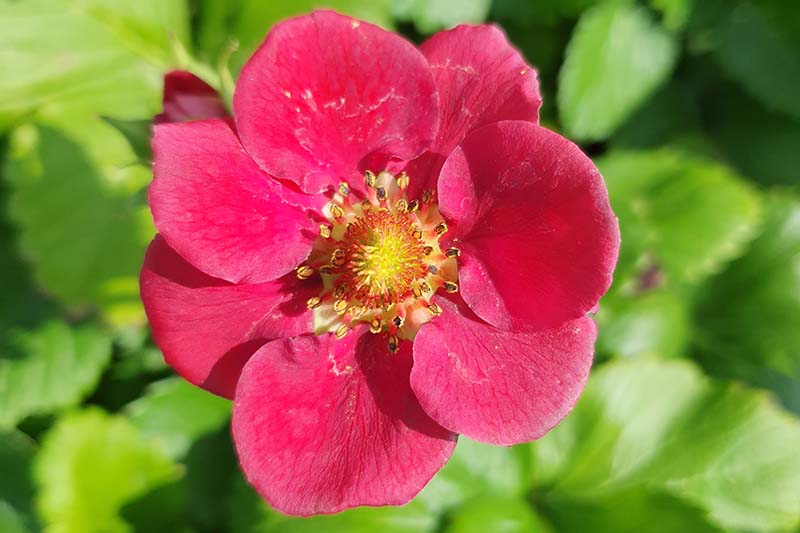
‘Ruby Ann’ is a looker, with large, deep red flowers and bountiful ruby-red fruit on trailing runners.
Best grown in Zones 3 to 8, this everbearing cultivar has a mounding habit and it does best in full sun.
Expect a height and spread at maturity of 10 to 24 inches.
Plants are available from Burpee.
28. Rutgers Scarlet
A June-bearing variety named for the university breeding program from whence it came and released in 2015, this Jersey type is juicy with a particularly delicious sweet-tart flavor, and it was “solely developed for fresh picking.”
Best in Zones 5 to 8, with a mounding habit and white flowers, grow ‘Rutgers Scarlet’ in full sun for the best yields.
You can expect this type to reach a height of eight to 10 inches and spread of 10 to 24 inches at maturity.
Plants are available from Burpee.
29. Seascape
A high yielding day-neutral plant that does well in a variety of soil types, ‘Seascape’ has a prostrate habit with large, conical, bright red berries that weigh about two ounces each.
Developed at the University of California and released in 1991, peak production for this cross between ‘Selva’ and ‘Douglas’ can be expected in August and September.
But according to Burpee, ‘Seascape’ will start fruiting about three months after you get it in the ground, regardless of what date you choose to plant.
Heat tolerant and very resistant to disease, this cultivar does best in full sun in Zones 4 to 8, and it’s known as a favorite among growers in California and the northeastern regions of the US. It is moderately susceptible to leaf rot.
With a height and spread of 12 inches by 23 to 36 inches, this type will also do well in containers, and fragrant white flowers are attractive to pollinators. You can expect 90 days to harvest, and 500 chill hours are required.
Packages of 25 bare root plants are available from Burpee.
And if you want to keep strawberry season going in your garden for as long as possible, Burpee offers an All Season Collection of ‘Earliglow,’ ‘Jewel,’ and ‘Seascape’ bare root plants in packages of 25 each.
30. Sweet Charlie
Bred at the University of Florida Gulf Coast Research and Education Center with growers in the southern states in mind, this June-bearing early-season cultivar is known for its high yields of super sweet and flavorful medium-sized berries with a firm texture.
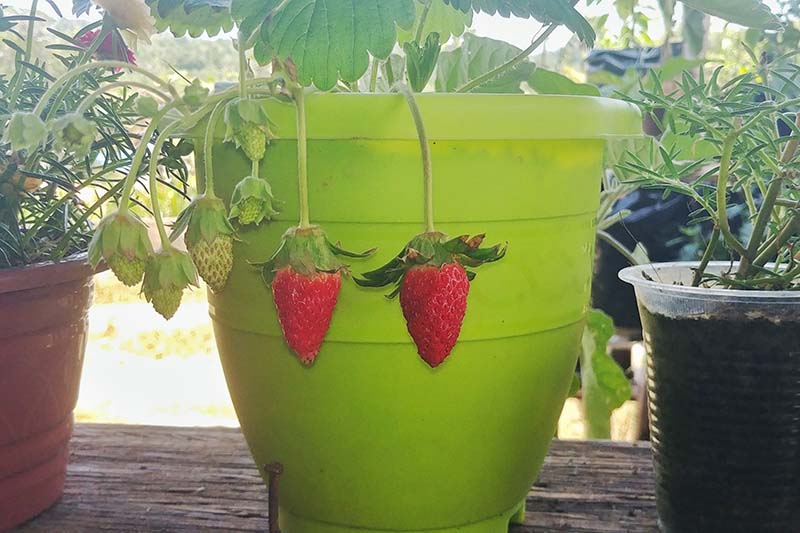
Expect one to two pints of fruit per plant, with larger berries produced at the beginning of the season. ‘Sweet Charlie’ is also known to provide a second crop of large fruit at the very end of the season in some years.
These vigorous plants have a prostrate growth habit, and with a height of 12 inches and spread of 12 to 20 inches at maturity, they can be grown in containers.
Best planted in full sun in Zones 5 to 8, ‘Sweet Charlie’ is a cross of ‘FL 80-856’ and ‘Pajaro.’
Highly resistant to Collectotrichum acutatum anthracnose fruit rot, this cultivar is also resistant to Phomopsis fruit rot, crown rot, two-spotted spider mites, and powdery mildew.
But unfortunately, this type is susceptible to leaf blight and Botrytis fruit rot.
Plants are available from Burpee and you can find packages of 25 bare roots available via Amazon.
31. Sweet Kiss
High summertime yields with large, wedge-shaped berries on small plants? Yes, please!
‘Sweet Kiss’ is perfect for growing in containers in full sun in Zones 5 to 8.
With a prostrate habit, this everbearing cultivar maxes out at 10 inches in height (usually somewhere closer to six to eight inches) with a spread of 12 to 16 inches.
Bare root plants in packages of 25 are available from Burpee.
The Three Great Strawberries Collection from Burpee also features this cultivar, along with ‘Earliglow’ and ‘AC Wendy’ in packages of 25 bare root plants each.
32. Toscana
A standout known for its fruit as well as its flowers, this everbearing variety from Dutch breeding company ABZ Seeds has tons of ornamental value, with deep rose-colored flowers, a lush prostrate habit, and sweet, small, dark red fruit.
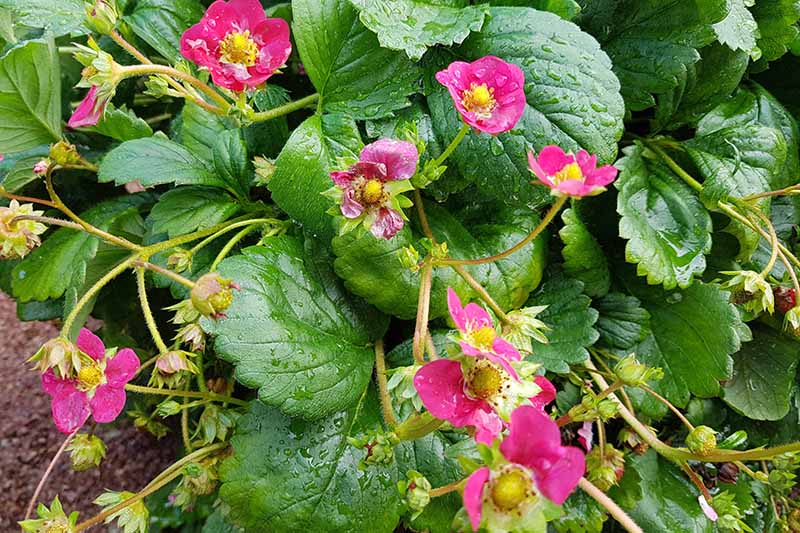
‘Toscana’ was a winner of the 2011 FleuroStar Award granted by Fleuroselect. And this F1 hybrid is frost tolerant and great for self-sowing.
Plant it in containers or hanging baskets, in full sun or partial shade, to decorate your outdoor space in Zones 4 to 9.
Expect a mature height of eight to 12 inches and spread of 12 to 16 inches.
Plants are available from Burpee.
33. Tristan
Another cultivar with equally impressive ornamental and edible value, ‘Tristan’ has deep rose-colored blooms and bright red berries.
These compact everbearing plants are known for being plagued with few problems, so they’re great for beginners. And kids will delight in harvesting their own sweet, homegrown berries.
Best grown in full sun in Zones 5 to 8, this type features a prostrate growth habit.
With a mature height of eight to 10 inches and spread of 14 to 18 inches, ‘Tristan’ is perfect for growing in containers as well as beds.
Plants are available from Burpee.
34. White Pineberry
You’ve probably seen photos of these floating around the internet, and they’re not a hoax. In fact, white pineberries are becoming incredibly popular among growers today!
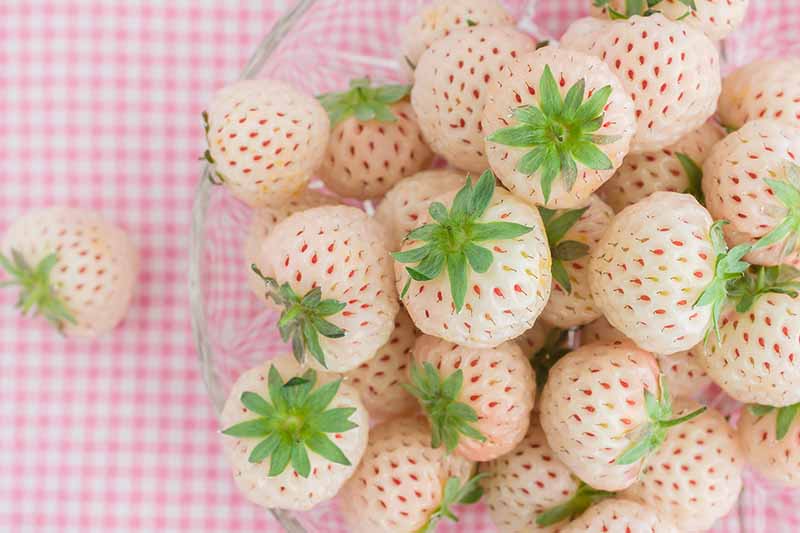
Dutch breeder Hans de Jongh developed this type from French source stock, and it was released in 2009.
Known for their white color and red seeds, F. virginiana x chiloensis ‘White Pineberry’ is almost like an inside-out or photo negative version of your typical strawberry.
Deer resistant, this unique cultivar is aromatic with a mild pineapple flavor, and it produces white flowers. No chill hours are required, and you can expect your first harvest in the second year.
Since they are only partially self-pollinating, another cultivar (such as ‘Quinalt’) is often also included with purchase to cross-pollinate and increase yields.
Even though these two types differ in appearance, they won’t develop hybridized fruit. Just keep in mind that seeds planted from either variety will not grow true to seed if they were cross-pollinated.
Both are everbearing, vigorous varieties that produce lots of unrooted runners – so they’re great for hanging planters – and ‘Quinalt’ produces red fruit.
Grow ‘White Pineberry’ in full sun in Zones 5 to 8 and expect a mature height of 10 inches.
You can find ‘White Pineberry’ plants in two-quart containers available from Fast Growing Trees or 25 bare roots available at Walmart.
Packages of 25 ‘Quinalt’ plants are available via Walmart.
35. Whopper
If you’re looking for an impressively large strawberry, you’ve come to the right place! ‘Whopper’ produces berries that rival peaches in size, and these plants are extremely hardy and eager to multiply.
Unlike some of the other larger cultivars, these are known for being sweet and juicy (because, as we all know, size isn’t the only thing that matters when it comes to homegrown fruit!).
This June-bearing cultivar is disease-resistant, hardy in Zones 5 to 10 with a mature height of eight to 10 inches and spread of eight to 12 inches.
With a medium growth rate, plants produce white flowers, and you can expect yields of one to three pints of fruit per plant.
Bare root plants are available in packs of 10 from Gurney’s via The Home Depot.
A Berry Patch Full of Luscious Fruit
In addition to several raspberry bushes, my grandpop always had a few strawberry plants growing in the beds alongside his house, and my uncle Norm actually grew up to be a strawberry farmer.
A passion for berries runs deep in my family.
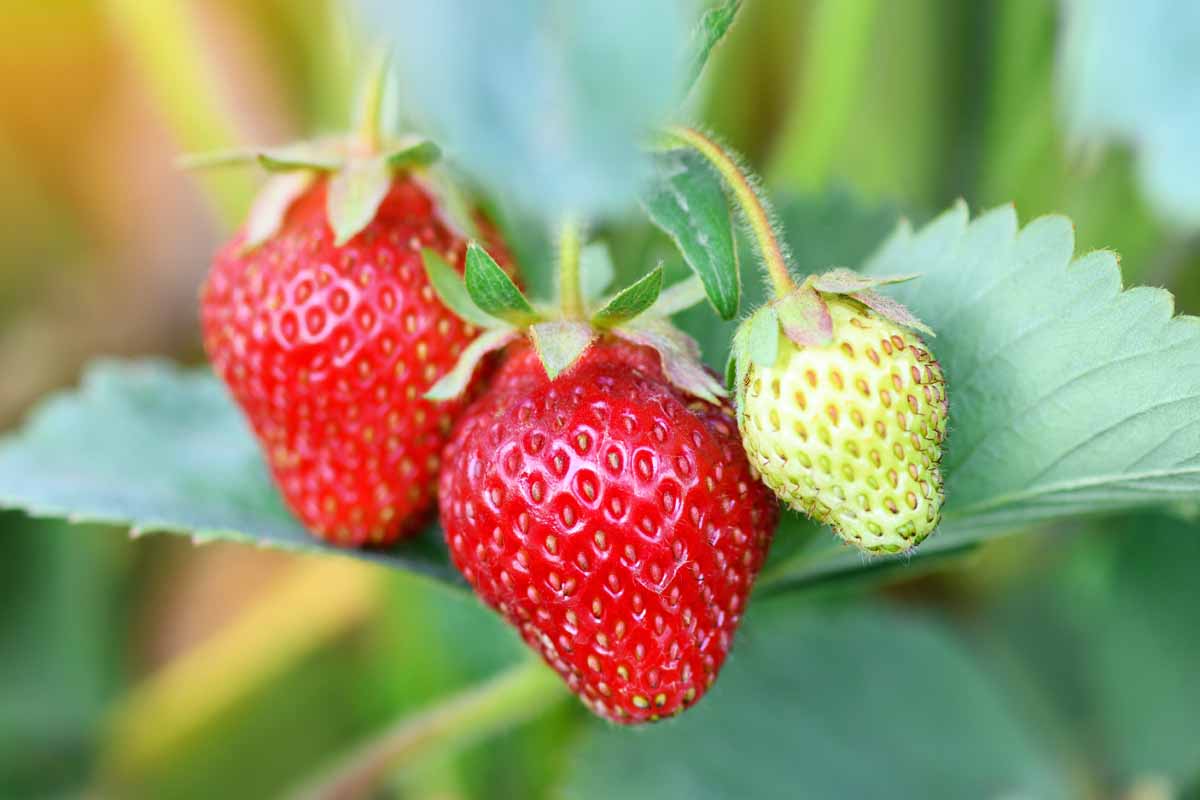
Who knows – maybe planting a few of these tasty cultivars will encourage the children in your life to develop a love of the land as well, pursuing careers in the agricultural sciences or growing into green-thumbed gardeners themselves, proud of their homegrown harvests.
Whether you crave just a few tasty and colorful berries each summer, continual harvests throughout the season, or a big batch of berries bursting with juice that you can pick for an all-hands-on-deck canning session, we hope you’ll find exactly what you’re looking for among our favorites.
What’s your go-to strawberry cultivar? Any suggestions to share? We love hearing from our readers – feel free to drop us a line in the comments below!
And if you want to learn even more about growing your own berries at home, take a look at these guides next:
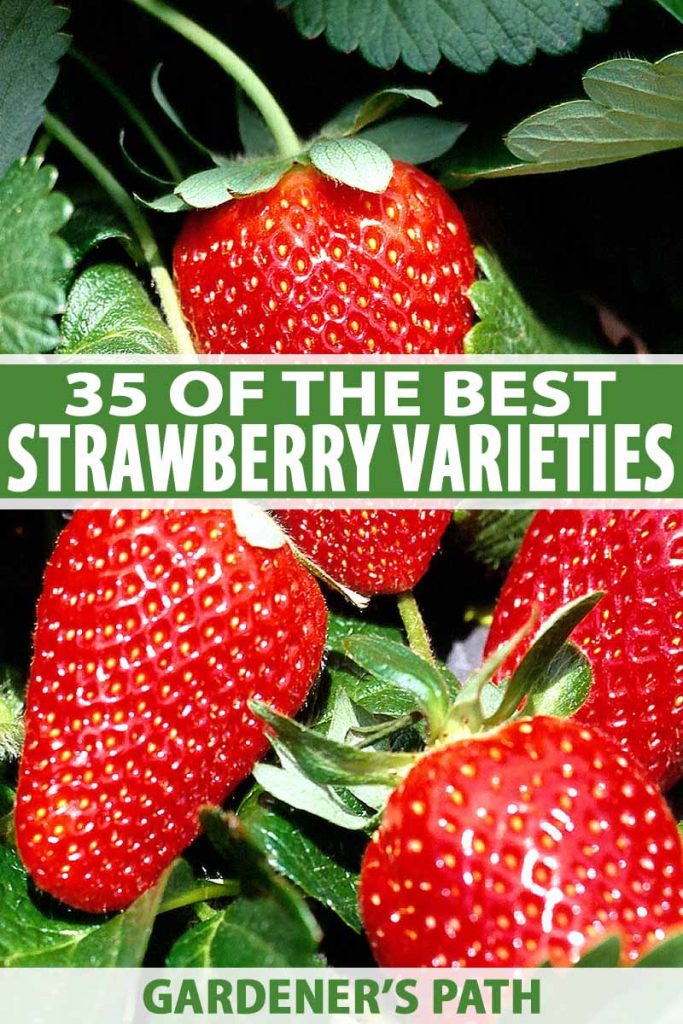
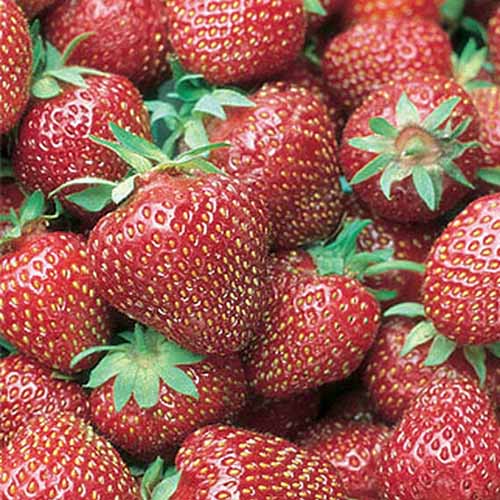

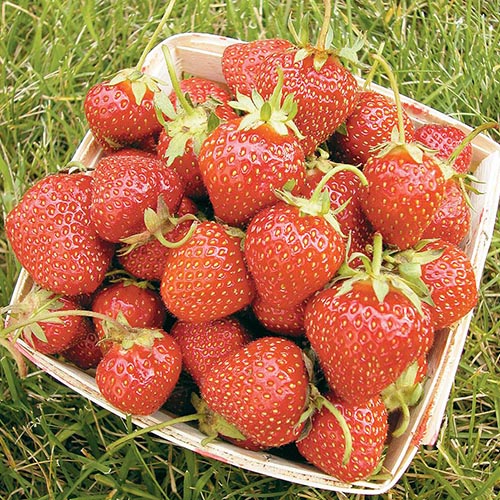


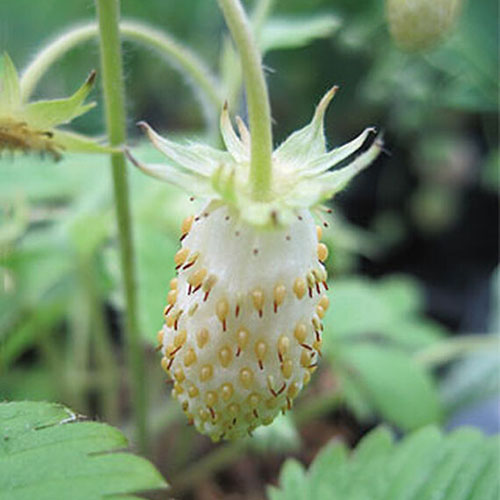
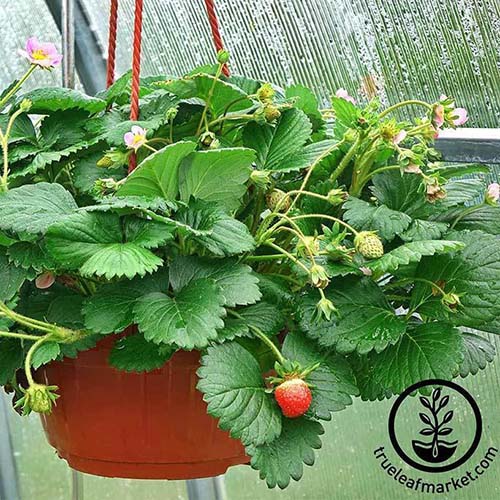
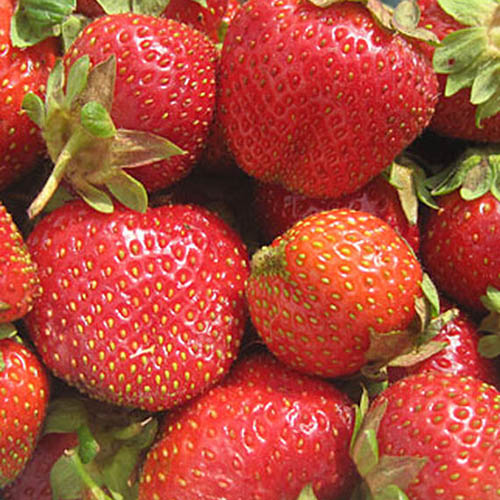
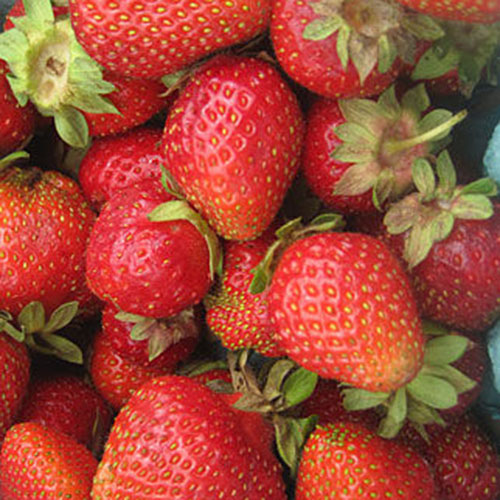
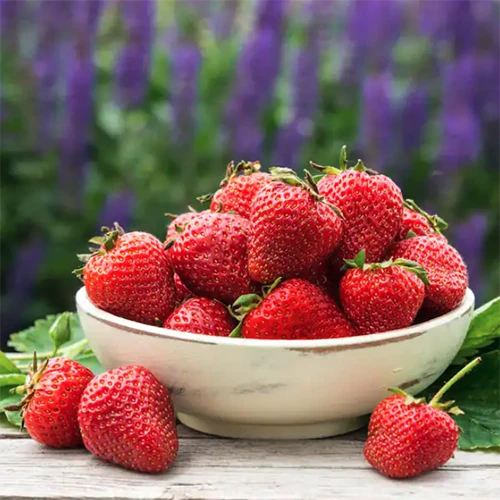

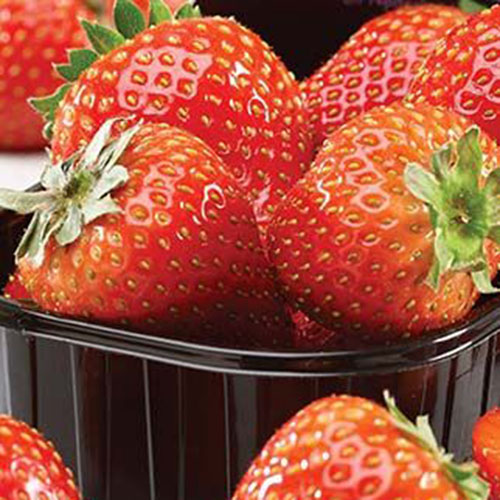
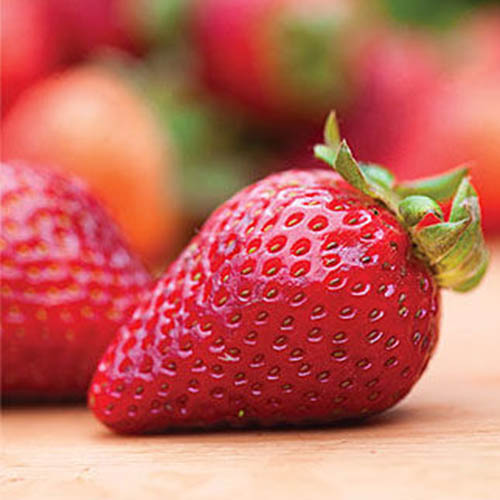
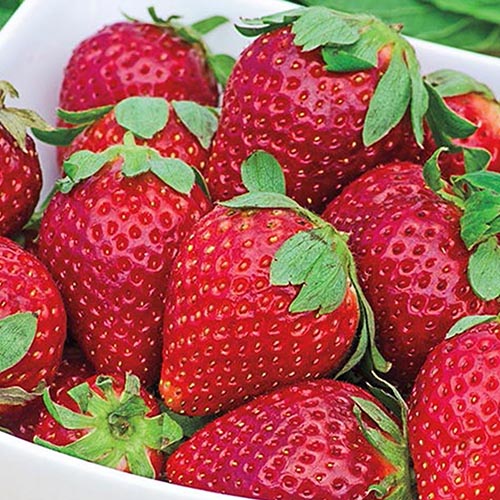
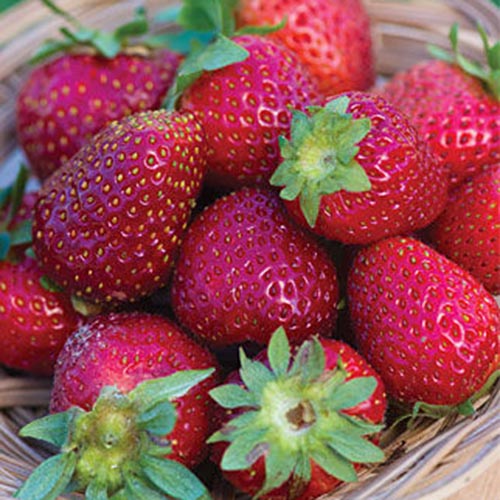
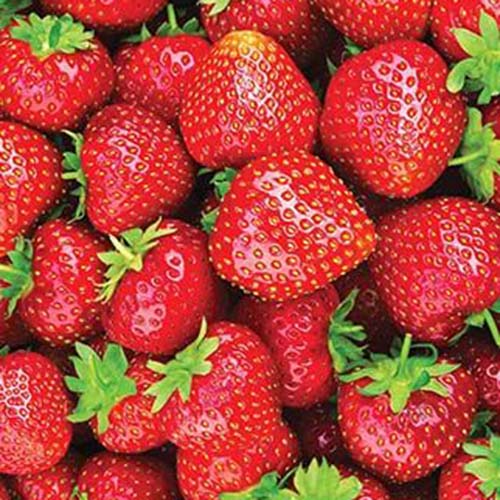
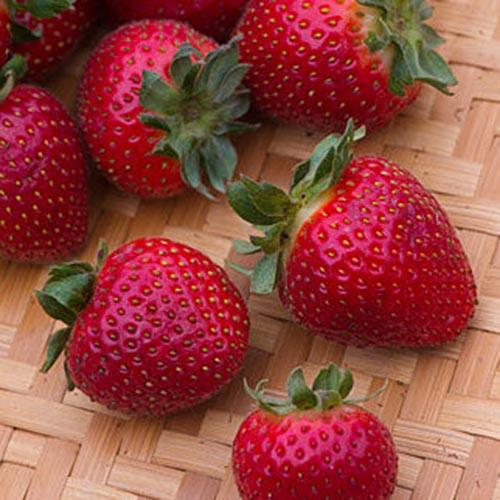


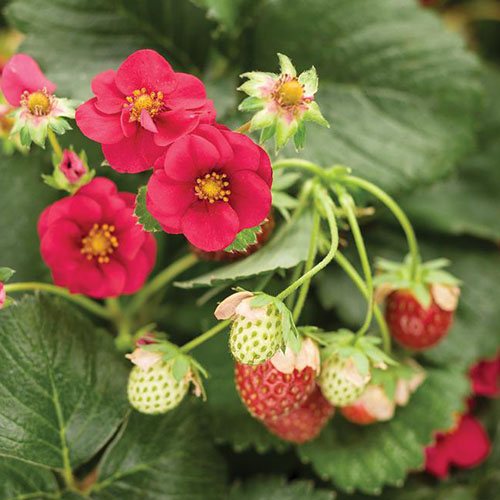
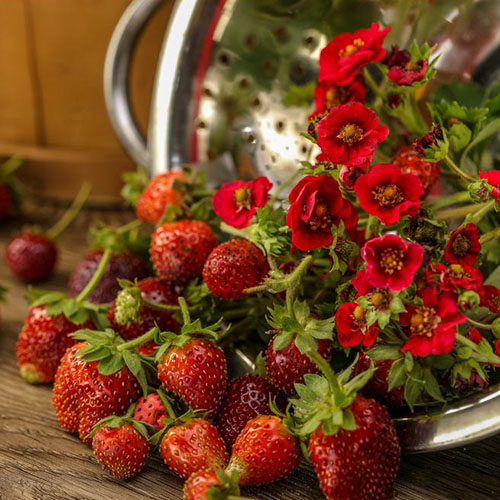
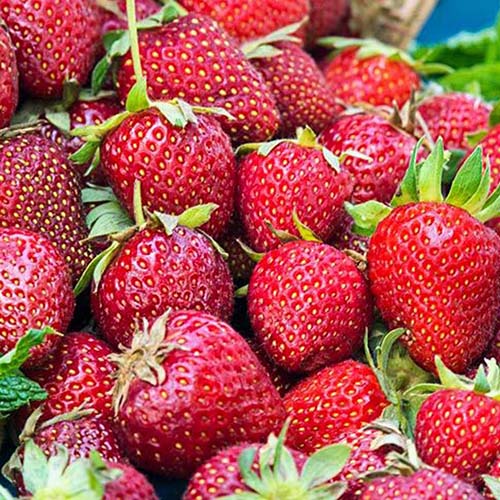
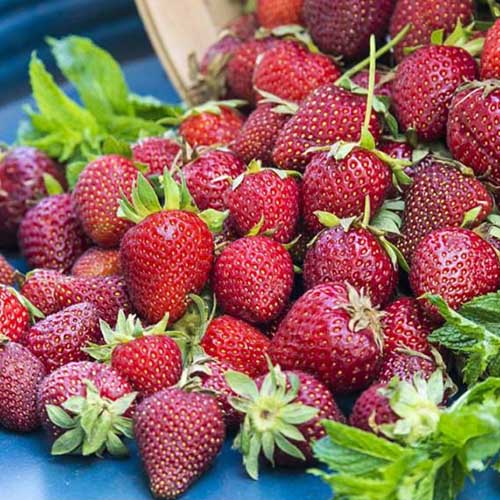
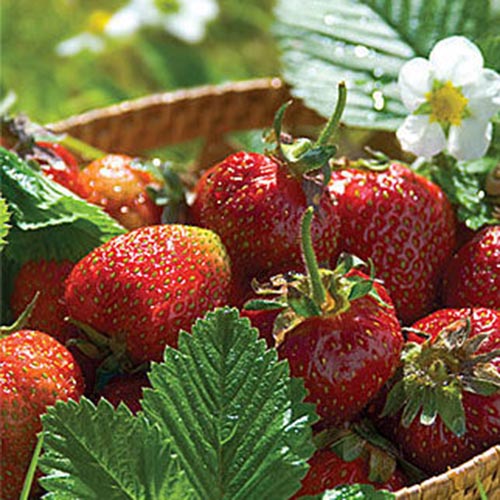
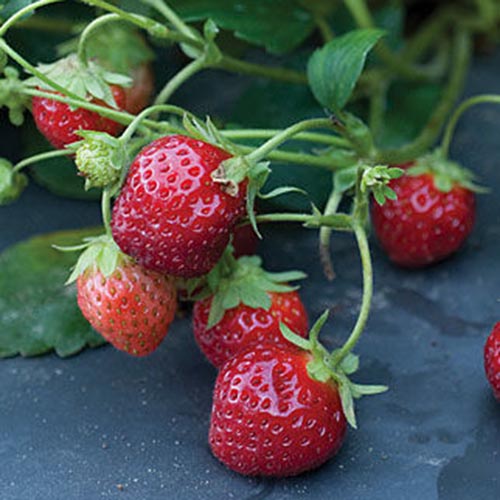
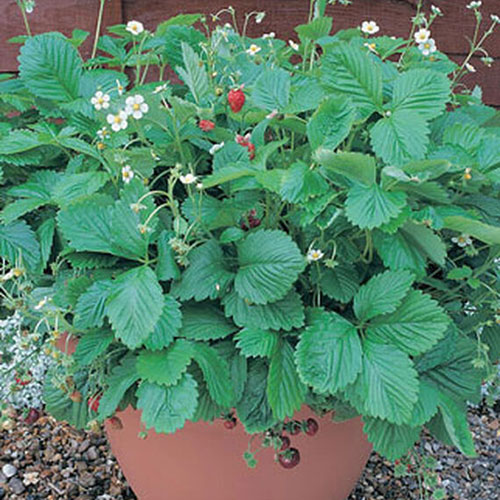


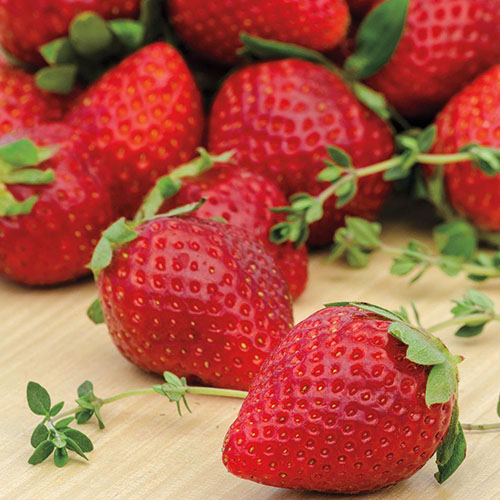
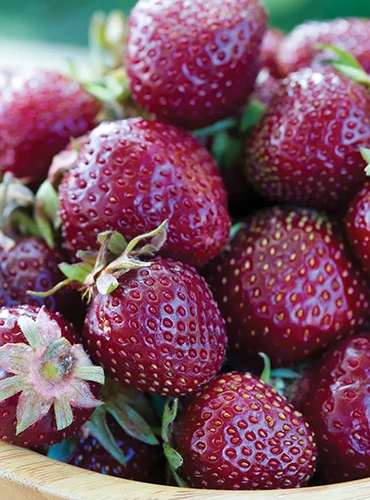
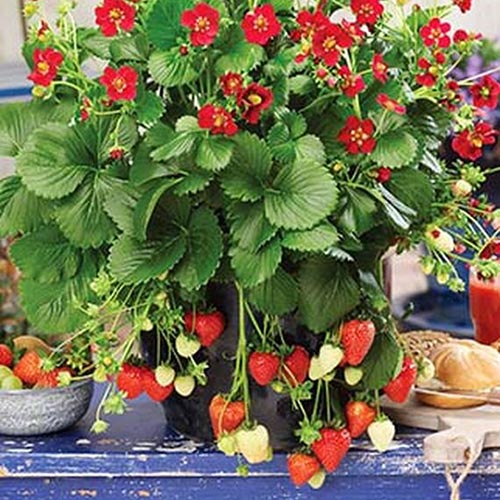
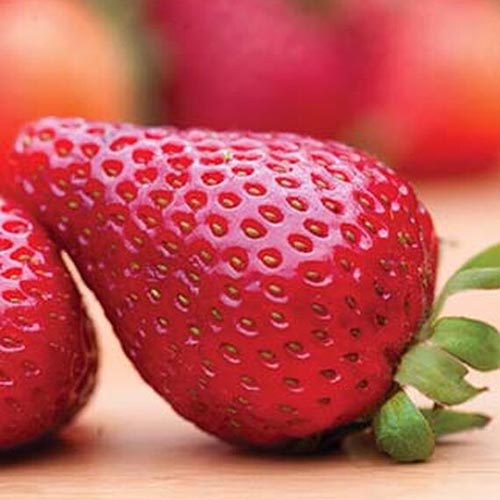
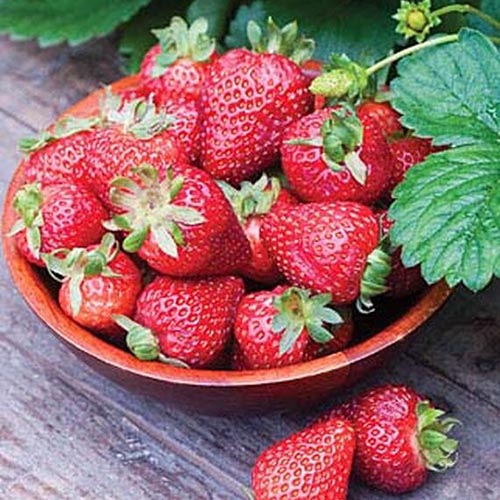
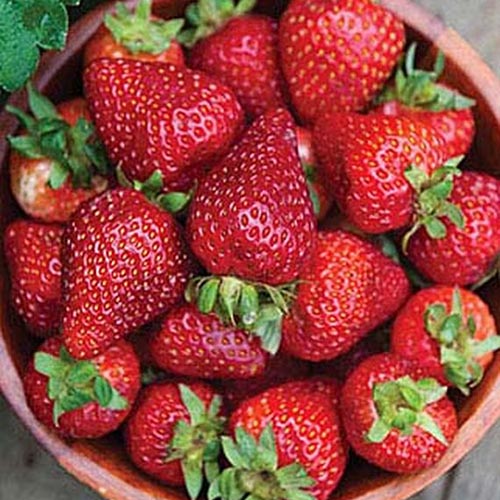
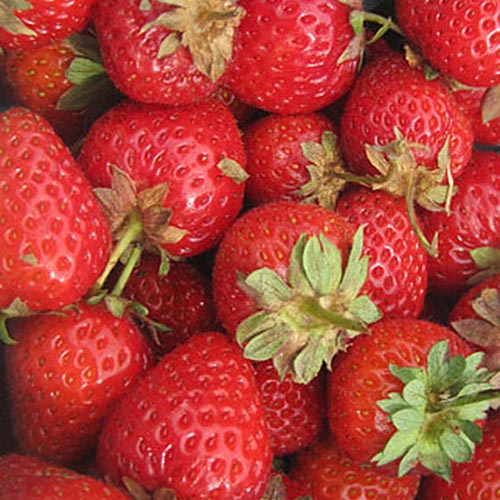
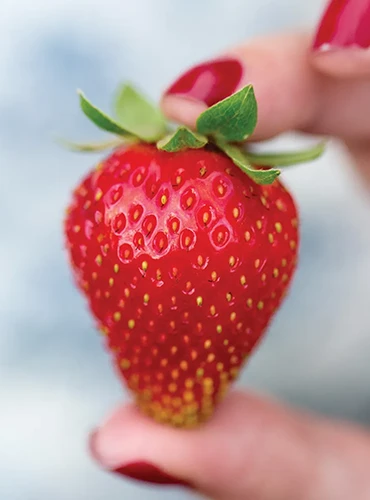
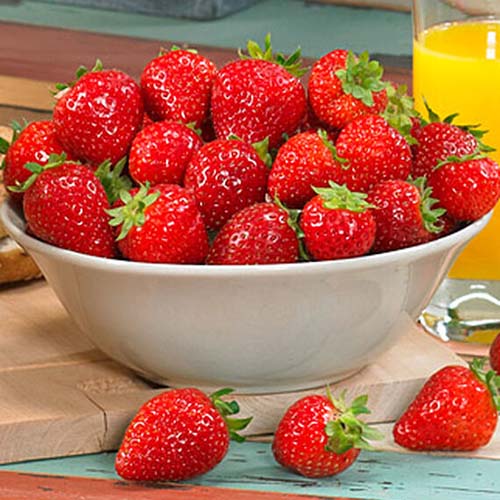

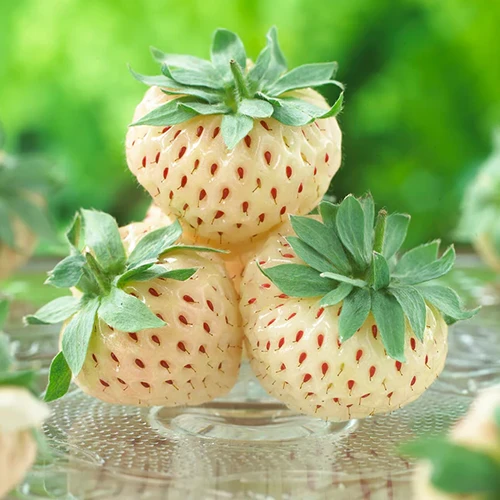
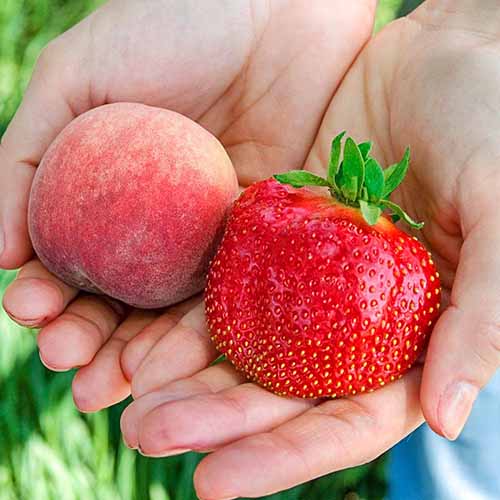
Excellent review, thanks
You’re welcome, Paul! Thanks for reading ????
not sure how helpful this was. At least I got my list down to about 12. I think I will try them all and see what grows best for me. Trying to get it narrowed down to 3 varieties for the ground and one in baskets. I am grateful for the thoroughness of your list.
Was so helpful and not helpful too.
I hear ya, Drew. This is a pretty thorough guide, since there are lots of wonderful strawberry varieties available, suited to different growing areas and with different growing habits. Please let us know where you’re gardening and if you have any more specific questions that we can help you with!
The Whopper from Gurney’s is pp16971 which I believe is the Cabot variety available at other catalogs.
My favorite for flavor is Sparkle
I found this article while Googling to determine if strawberries bred true. The text in the Google search was so confusing, I clicked on this article, where I continued to see this extremely confusing line: “A true F1 hybrid, ‘Delizz’ strawberry seeds grow true, meaning this is a good candidate for seed saving if that’s something you’d like to try.” That’s… simply not how plant hybridization works. An F1 hybrid is the first filial generation of interbreeding two specific varieties. The resulting hybrid appears quite uniform during the first generation, but the second generation is the least phenotypically stable that… Read more »
You’re correct, Reggie- thanks so much for catching our mistake! We’ll post an update to correct this error ASAP.
Hello madam, thank you for sharing with this information about strawberry, where can i buy those varieties?
Thanks in advance.
Thanks for reading! Just follow the links for purchase information from our recommended affiliate vendors.
Very interesting and inspiring strawberry…Ms.Allison
If you have time, Please categorize the field of land and climate to cultivate them, which one the most suitable and also the vitamins ingredient.
Explore more in the wild field please…
Thank you, Padrinox! Climate requirements are indicated by the recommended USDA Hardiness Zones listed for each variety, and the nutritional content of all varieties is comparable across the board, providing a good source of vitamin C as well as other nutrients. You can read more about the conditions required for cultivation in our guide, including soil and fertilizer requirements. And we hope to cover wild strawberries in more detail in the future!
I planted some strawberry plants this year the runners bearing fruit have to tied up a support cage . apparently the plants were developed by grafting onto a tree . I was given these to plant quite successful nice , sweet and juicy fruits . Any ideas of the name please ?
Hi Brian, any chance you can share a picture and we’ll try and help you out? Thanks!